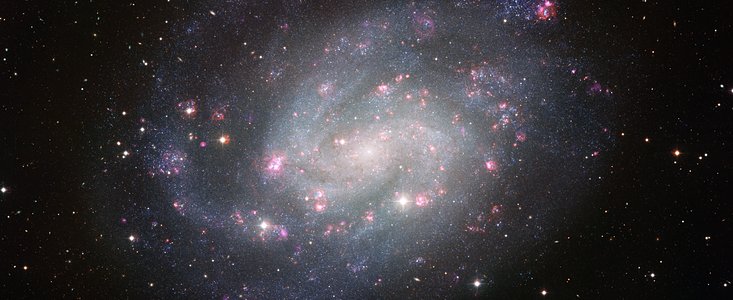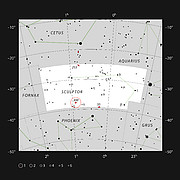Persbericht
Een nabije galactische soortgenoot
8 september 2010
De Europese Zuidelijke Sterrenwacht (ESO) heeft een spectaculaire nieuwe foto vrijgegeven van NGC 300. Dit spiraalstelsel, dat zich in de nabije Sculptorgroep bevindt, vertoont sterke overeenkomsten met ons melkwegstelsel. De foto is het resultaat van een alles bij elkaar vijftig uur durende opname met de Wide Field Imager (WFI) van de ESO-sterrenwacht op La Silla (Chili). NGC 300 bevindt zich op een afstand van ongeveer zes miljoen lichtjaar en lijkt vanaf de aarde gezien ongeveer een derde kleiner dan de volle maan.
NGC 300 is in de negentiende eeuw vanuit Australië ontdekt door de Schotse astronoom James Dunlop. Het is een van de meest nabije en indrukwekkende spiraalstelsels van de zuidelijke hemel, helder genoeg om met een verrekijker waarneembaar te zijn. Samen met een aantal andere stelsels vormt NGC 300 de zogeheten Sculptorgroep [1], die in het onopvallende sterrenbeeld Sculptor (Beeldhouwer) staat. Ook enkele andere leden van deze groep zijn met ESO-telescopen vastgelegd, waaronder NGC 55 (eso0914), NGC 253 (eso1025, eso0902) en NGC 7793 (eso0914). Veel sterrenstelsels vertonen wel de een of andere afwijking, maar NGC 300 lijkt opmerkelijk normaal. Dat maakt het stelsel tot een ideaal onderzoeksobject voor astronomen die zich met de structuur en samenstelling van spiraalstelsels als het onze bezighouden.
Deze foto, gemaakt met de Wide Field Imager (WFI) van de ESO-sterrenwacht op La Silla (Chili), is opgebouwd uit vele afzonderlijke opnamen die door allerlei verschillende kleurfilters zijn gemaakt. Alles bij elkaar is er, verspreid over enkele jaren, bijna vijftig uur licht van NGC 300 verzameld. Het belangrijkste doel van deze uitgebreide waarnemingscampagne was om een gedetailleerd overzicht te verkrijgen van de stellaire bevolking van het stelsel. Niet alleen zijn de verschillende soorten sterren getalsmatig in kaart gebracht, ook zijn specifieke gebieden en sterren geselecteerd die om nader onderzoek vragen. Maar dit rijke gegevensbestand zal daarnaast ook nog jarenlang voor andere doeleinden worden gebruikt. Door het stelsel te bestuderen met filters die licht van met name waterstof en zuurstof doorlaten, zijn de vele stervormingsgebieden langs de spiraalarmen van NGC 300 op deze foto opvallend duidelijk herkenbaar als rode en roze wolken. Dankzij zijn grote beeldveld van 34 bij 34 boogminuten – vergelijkbaar met de schijnbare afmetingen van de volle maan vanaf de aarde gezien – is WFI een ideaal astronomisch instrument voor het onderzoek van grote objecten zoals NGC 300.
In en rond NGC 300 spelen zich tal van interessante astronomische verschijnselen af die met ESO-telescopen zijn onderzocht. Onlangs ontdekten ESO-astronomen in dit stelsel een stellair zwart gat –een van de zwaarste die tot op heden gevonden zijn – dat samen met een hete, heldere Wolf-Rayetster een dubbelster vormt (eso1004). Ook is gebleken dat NGC 300 en het naburige stelsel NGC 55 traag naar elkaar toe spiralen en uiteindelijk zullen samensmelten(eso0914). Met onder meer de Very Large Telescope van de ESO-sterrenwacht op Paranal hebben astronomen de tot nog toe beste schatting van de afstand tot NGC 300 verkregen (eso0524).
Noten
[1] Hoewel het stelsel doorgaans tot de Sculptorgroep wordt gerekend, laten de meest recente afstandsmetingen zien dat NGC 300 aanzienlijk dichter bij staat dan veel andere stelsels in de groep. Mogelijk is zijn binding met de overige stelsels slechts gering.
Meer informatie
ESO, de Europese Zuidelijke Sterrenwacht, is de belangrijkste intergouvernementele sterrenkundeorganisatie in Europa, en het meest productieve astronomische observatorium ter wereld. ESO wordt ondersteund door 14 landen: België, Denemarken, Duitsland, Finland, Frankrijk, Italië, Nederland, Oostenrijk, Portugal, Spanje, Tsjechië, het Verenigd Koninkrijk, Zweden en Zwitserland. ESO voert een ambitieus programma uit, gericht op het ontwerp, de bouw en het beheer van krachtige grondobservatoria die astronomen in staat stellen om belangrijke wetenschappelijke ontdekkingen te doen. ESO speelt ook een leidende rol bij het bevorderen en organiseren van samenwerking op sterrenkundig gebied. ESO beheert drie waarnemingslocaties van wereldklasse in Chili: La Silla, Paranal en Chajnantor. Op Paranal staat ESO’s Very Large Telescope (VLT), de meest geavanceerde optische sterrenwacht ter wereld. Ook is ESO de Europese partner van de revolutionaire telescoop ALMA. Daarnaast is ESO momenteel bezig met ontwerpstudies voor de 42-meter Europese Extremely Large optische/nabij-infrarood Telescoop (E-ELT), die ‘het grootste oog op de hemel’ ter wereld zal worden.
Contact
Richard Hook
ESO, La Silla, Paranal, E-ELT and Survey telescopes Press Officer
Garching bei München, Germany
Tel: +49 89 3200 6655
E-mail: rhook@eso.org
Marieke Baan (Perscontact Nederland)
ESO Science Outreach Network
en NOVA Informatie Centrum
Tel: +31(0)20-5257480
E-mail: eson-netherlands@eso.org
Over dit bericht
| Persberichten nr.: | eso1037nl |
| Naam: | NGC 300 |
| Type: | Local Universe : Galaxy : Type : Spiral |
| Facility: | MPG/ESO 2.2-metre telescope |
| Instruments: | WFI |




